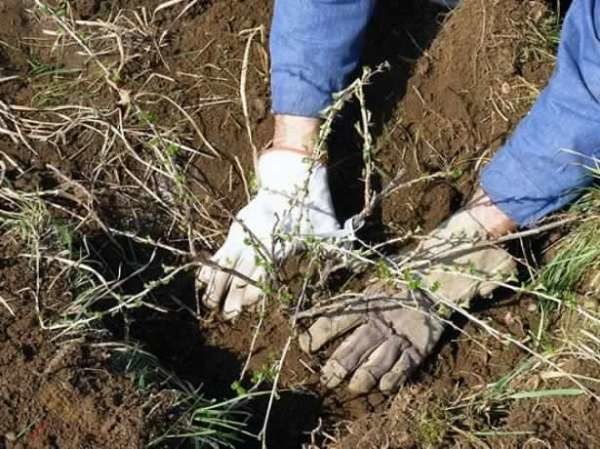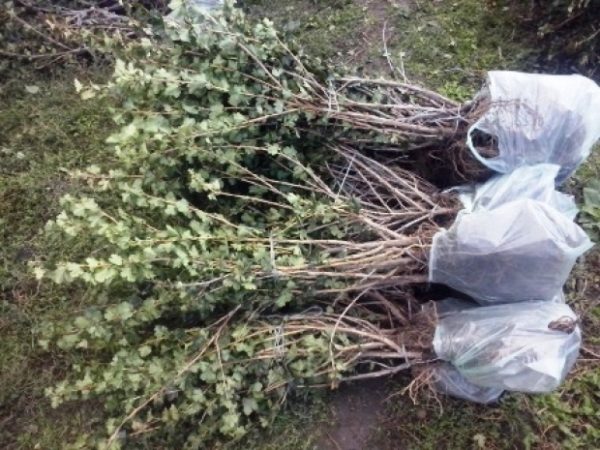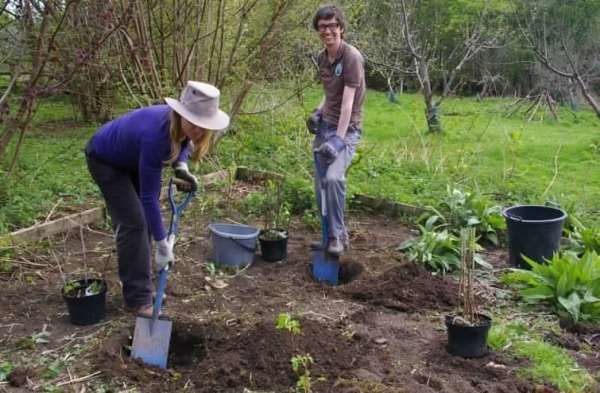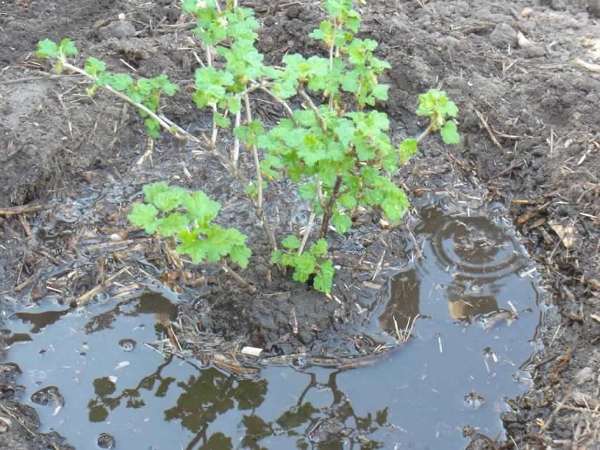Gooseberries are grown in our country for a long time. In Russia, already in the 11th century, monks bred cultivated varieties of this berry in the monastery gardens. Thus, the gooseberry was cultivated much earlier than the popular currants and raspberries. Now the fruits of this berry are valued for the rich composition of vitamins, healing properties and delicious gooseberry jam. Although the plant is unpretentious, it grows on the territory of Russia, Ukraine, it is necessary to approach its planting with full responsibility. Planted with all the rules, the gooseberry is able to produce yields of up to 10 kg per year for 40 years. Let's take a closer look at the rules for planting gooseberries in the fall.
Table of contents
Landing time
Gooseberries are planted in both spring and autumn. In spring, planting should be done as early as possible, preferably in the first half of April.. It is important that the plant has not yet departed from the winter state of rest. If the buds begin to bloom, then the chances that the seedling will take root will decrease. But the shrub planted in time will have a worse survival rate in the spring than during the autumn planting. In what month to plant gooseberries, you ask? Gardeners with experience recommend planting gooseberries late August - September month - early October, depending on the region - Moscow region, the Urals, the middle belt of Russia.

The best time for autumn planting is the last week of September and the first weeks of October.. However, you need to focus on the weather. The main thing is that the first frosts come no earlier than in two weeks, and the young roots will not freeze. And the day is better to choose a non-solar and without wind, so that the roots in the open air do not dry out.
With the right choice of planting time in the fall, the plant takes root in almost 100% of cases. Among other advantages of the autumn planting are:
- Before the onset of cold weather, there is time to the roots of the seedling had time to grow strong and grow.
- Strong plant in spring will begin to develop rapidly.
- Before winter the soil around the shrub will settle well and thicken.
- A plant that survived in the fall spring will begin the process of growing season with full forceThat will provide a greater increase in young shoots by next fall.
Planting gooseberries in the fall, although it gives great guarantees, it is very important not to be late with its terms.
If you have decided on the correct date, a significant moment for a successful planting is the preparation of a plant seedling.
How to choose and prepare a sapling
When buying a seedling, be sure to pay attention to the following indicators:
- Sapling age. It should not exceed two years; an adult plant will take longer to settle down and adapt to new conditions longer.
- Quite a large number of roots. Among them should be three or more skeletal, the length of which exceeds 15 cm. And much more fibrous roots.
- Shoots aboveground parts of the plant in length should reach 30-40 cm.

After buying a seedling, it is prepared for planting. For this you need:
- Remove the leaves from a sapling.
- Trim dry roots.
- Lower the seedling into the clay talkerprepared in advance. To prepare the solution, mix the clay and black soil 1 kg each, 2 packs of Kornevin products, and pour 3 liters of water.
Location selection
It is equally important to choose the right place for future landing. Where to plant this fruit bush? It is not necessary to plant gooseberries between the trees, it will create a shortage of sunlight. The proximity to the currant is also detrimental to the plant, because they are subject to the same diseases and pests. Well, if before planting a gooseberry on this land were grown legumes, beets or potatoes.
The correct placement of bushes when planting several plants at once is also important. Gooseberry grows pretty well. The eight-year bush reaches 2.5 meters in diameter.

There are several gooseberry planting patterns.:
- Sparse landing. In this case, the bushes are planted in rows at a distance of 1.5 meters from each other, and between the rows leave a space of 2 meters wide. After 4-5 years, the plants will grow so that they will be a single continuous strip.
- Planting between rows of young fruit trees. In such conditions, the gooseberry will grow well until the crowns above it close up. After that, the bushes should be transplanted to a more lighted place.
- Combined circuit. The plants are planted in rows at a distance of 75 cm from each other, keeping a distance of 1 m between the rows. When, a few years later, the bushes begin to close, they need to be thinned out through one by transplanting part of the plants to a new place. After another couple of years, the thinning should be repeated. Such a scheme contributes to a greater yield of berries and saves space on the site.
For the accelerated receiving a plentiful harvest, gardeners sometimes plant two seedlings at once in one large hole, leaving the distance between them 20 cm. In the early years, the harvest will indeed be quite good, however, the bushes will soon begin to thicken and grow much older. In this case, their roots will be so intertwined that it will be almost impossible to plant plants.
When you prepare the seedlings and choose a good place for the gooseberry, you can proceed to the direct planting of the plant.
Gooseberry planting technology in spring and autumn
Planting a plant includes the following steps:
- On the selected site you need dig the ground no more than a spade. In this case, all the clumps are broken and weeds are eliminated.
- Dig a hole, its size should slightly exceed the root system of the seedling, on average this 50x50x50 cm. This should be done a little in advance - a couple of weeks before the landing. The upper fertile ground must be folded on one side, and the rest on the other.
- Fertilize the pit. At 2/3 of it must be filled with fertile soil, mixed with compost (1.5 buckets), superphosphate (300 g), peat (1.5 buckets), ash (3 cups), ground limestone (1 cup).From above you should pour more fertile land and pour all this 0.5 liters of water.
- Before landing hole must be left to stand in this form a couple of weeksso that the soil is sufficiently settled.
- During a direct landing, place the seedling in the hole, tilting it slightly. In this case, the root neck should be located in the very center of the fossa, and the roots should be laid out on the sides. To avoid voids, the space between the roots should be covered with earth. Gooseberries are usually deepened. 5 cm belowthan the last place of growth of seedlings (it's easy to track down the trail on the bark). Thus, conditions will be created for the growth of additional roots and shoots from the plant's buried buds.
- The land around the seedlings need trample and pour heavily.
- Put a mulch in the hole 10 cm of peat or leaves.
After landing in the fall, young plants do not require special care, you can not touch them until spring. Mulch and fallen snow will help the sapling to winter. If you are afraid that there will be little snow in winter, you can additionally warm the gooseberry with covering materials.
After landing in spring, for survival and growth, cut the plant.At the same time, cut the above-ground part by 10 cm, and leave 2-3 buds on each shoot. When autumn planting such pruning is not recommended. If you do decide to do it, be sure to cover all the cuts with garden pitch.
How to transplant an adult bush
When choosing a planting scheme with further sparging of rows, it is important to know the rules of gooseberry transplantation. Plants should also be transplanted in the fall so that the plants take root more easily in the new place. To safely remove a shrub from the ground, dig it in from each side at a distance. 30 cm from the base. Thick roots can be chopped off, it does not harm the plant. Then, using a shovel, the bush is removed from the soil, together with the earthy lump is placed on polyethylene and moved to a new planting site. The technology itself planting adult plants has no differences from planting seedlings.
Such a non-capricious plant, like a gooseberry, does not require constant care for it. It is enough to give him time one day.by planting according to all the rules, and for many years the plant will provide you with a tasty and healthy harvest.
